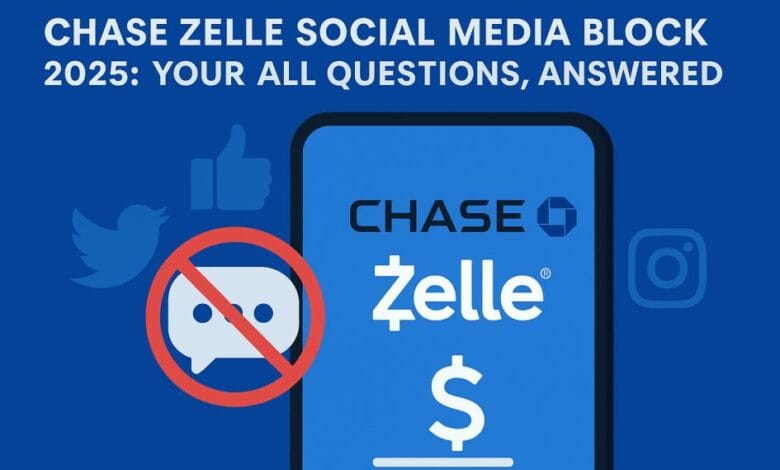
Chase Zelle Social Media Block 2025: Your Questions, Answered
In early 2025, JPMorgan Chase introduced a new security feature aimed at safeguarding customers from the rise in peer-to-peer payment fraud linked to social media. Called the Chase Zelle Social Media Block, this initiative allows Chase to delay, refuse, or block Zelle payments that seem to arise from interactions on platforms such as Facebook Marketplace, Instagram, Reddit, or various online communities.
Starting on March 23, 2025, this measure seeks to balance security with convenience by blocking suspicious transactions while still upholding Zelle’s promise of instant payments. This detailed guide explores the reasons behind Chase’s introduction of this policy, its operational mechanics, the people impacted, and practical tips for adapting to the new guidelines effectively.
What Is the Chase Zelle Social Media Block?
The Chase Zelle Social Media Block is an enhancement to Chase’s existing P2P payment rules that specifically targets fraud risk associated with social-media origin transfers. Under this policy:
- Paused Transactions: Payments flagged by Chase’s algorithms are held temporarily to collect more context.
- Processing Delays: Sometimes, even after more checks, certain transfers might be intentionally held up for more risk assessment.
- Rejected Transactions: Payments can be completely stopped if the sender fails to answer security queries or provides insufficient documentation.
- Declined Payments: Transactions are outright blocked if the sender cannot satisfy security questions or supply credible documentation.
Important aspects involve using natural language processing to examine transaction notes for marketplace keywords and employing behavioral models to identify abnormal behaviors. By concentrating on social media channels, Chase seeks to lower P2P fraud, which is thought to be in the hundreds of millions each year, while also decreasing the number of false alarms for genuine users. the social-media vector, Chase aims to reduce P2P fraud estimated at hundreds of millions annually while minimizing false positives for legitimate users.
Why Chase Introduced the Block in 2025
Fraud data from late 2024 showed that approximately 45% of Zelle scams involved victims first contacting sellers on social media. Wide-ranging scams ranging from counterfeit merchandise on social marketplaces to advanced impersonation schemes in direct messages exposed gaps in purchase protection. Regulatory pressure amplified the urgency:
Concerns for Consumer Protection: Federal agencies called on banks to fix gaps in real-time P2P systems.
Reputational Risk: High-profile cases of irreversible losses bolstered calls for proactive measures.
Industry Dynamics: Competing banks began exploring similar safeguards, indicating a broader shift toward “safer instant payments.”
Chase’s adoption of the social-media block reflects both a strategic response to heightened fraud rates and a commitment to leading best practices in digital payment security.
Timeline: Key Dates For Implementation
- February 2025: Initial announcement via in-app alerts and email bulletins, giving customers a heads-up and offering educational resources.
- March 1–10, 2025: Soft-launch window where flagged transactions generate advisory notices rather than hard blocks, allowing customers to adapt.
- March 23, 2025: Official enforcement begins. All transactions meeting the policy criteria enter the full verification workflow.
- April–June 2025: First-phase monitoring; Chase adjusts algorithm thresholds and refines risk models based on real-world data.
- July 2025 onward: Continuous policy review and public updates, including potential expansions or relaxed criteria based on fraud trends and customer feedback.
This phased approach aims to reduce customer friction while ensuring fraud detection is robust from day one.
Which Transactions Trigger The Block?
Chase’s risk detection combines several signals to pinpoint high‑risk payments:
- Keyword Patterns: Terms like “for sale,” “listing,” “marketplace,” and specific platform names appearing in the memo field.
- Recipient Novelty: Transfers to phone numbers or emails not previously transacted with, especially if they coincide with large group blasts or repeated test payments.
- Velocity Indicators: Multiple small-dollar transfers over a short period to different recipients typical of marketplace sellers.
- Geolocation Discrepancies: Sender and recipient IP or device origins showing anomalous distance or sudden changes.
When these factors converge, the payment enters the chase zelle social media block workflow. Customers see a clear message prompting them to verify transaction details through the Chase app or secure messaging.
How the Block Process Works: From Detection to Resolution
- Detection Engines: Real-time analytics scan transaction metadata, memos, device fingerprints, and behavioral patterns.
- Automated Interception: Flagged transactions are paused automatically; customers receive a push notification or email alert.
- Customer Verification: Users complete an in-app questionnaire detailing how they met the payee, transaction purpose, and any relevant documentation (screenshots of listings, business licenses for merchants).
- Risk Review:
- AI Triage: Models score responses and context data for fraud likelihood.
- Human Oversight: Complex or borderline cases escalate to Chase’s fraud-investigation team for manual review.
- Final Decision:
- Approved: Transaction proceeds to settlement.
- Delayed: Extended hold for deeper analysis (up to 72 hours).
- Declined: Funds are returned to the sender’s account; a summary of reasons is provided.
This hybrid approach meshes machine speed with human expertise, aiming to minimize both fraud and legitimate transaction disruptions.
Exemptions: Who Is Not Affected?
To avoid penalizing routine uses of Zelle, Chase established clear exemptions:
- Trusted Contacts: Recipients already on your ‘Favorites’ list or with prior cleared transactions.
- Registered Businesses: Small‐business accounts that completed Chase’s merchant‑onboarding process and provided tax or business-registration documents.
- Low-Value Personal Transactions: Transfers under a predetermined threshold (e.g., $250) tagged as “personal” or “gift.”
- In-Branch Initiations: Payments initiated or approved through a physical branch with teller oversight.
Exempt status is dynamic; an account could lose exemption if transaction behavior shifts dramatically, for example, a trusted contact suddenly receiving unusually high volumes of marketplace-style payments.
User Impact: What This Means For You
While the block enhances security, it also introduces new steps:
- Anticipate Verifications: Expect to answer questions when buying items through social channels—particularly high-value or unique products.
- Plan for Delays: Adjust timelines for purchases; plan to initiate payments a few days in advance if time-sensitive.
- Prepare Documentation: Keep digital copies of invoices, listings, or seller profiles to expedite verifications.
- Educate Social Networks Peers: If you often transact in community groups, inform fellow members about potential holds to manage expectations.
By proactively adopting these behaviors, you’ll reduce friction and avoid surprises when using Zelle for non-traditional payment scenarios.
Top Tips to Avoid the Block
- Confirm Identities Thoroughly: Use independent verification tools, check seller reviews, request official IDs, or verify business registrations.
- Craft Precise Memos: Include specific details such as product name, invoice number, or service dates to clarify transaction context.
- Conduct Test Transactions: Send a nominal amount to new contacts to establish a trusted-transaction history before larger payments.
- Leverage Secure Messaging: Use the Chase secure message feature to attach chat screenshots or listing links directly within the verification flow.
- Utilize Trusted Contacts Feature: Actively add frequent payees to your trusted contacts list after successful small-value transactions.
- Diversify Payment Methods for High-Value Deals: For transactions above $500, consider credit cards with purchase protection or escrow accounts designed for marketplace purchases.
Implementing these proactive practices will minimize the likelihood that your payments are flagged or blocked.
Alternative Payment Options
When a Zelle transfer is delayed or declined, evaluate these alternatives:
- PayPal Goods & Services: Offers comprehensive buyer/seller protection programs, including dispute mediation and chargeback rights.
- Venmo Business Profiles: Enables purchases with basic safeguards and in-app purchase tracking.
- Escrow Services: Specialized platforms that hold funds until both parties confirm receipt, ensuring transaction integrity.
- ACH/Wire Transfers: Bank-originated transfers that, while slower and potentially fee-laden, include traceability and reversal options through formal bank dispute processes.
Balance cost, speed, and protection levels to select the method best matching your transaction’s risk profile.
Conclusion
The Chase Zelle Social Media Block 2025 represents a significant advancement in protecting consumers from the evolving threat of P2P fraud. By specifically targeting transactions that originate on social media where purchase protections are weakest, Chase has created a tailored deterrent against common scams. The policy’s multi-stage verification workflow ensures that legitimate payments proceed with minimal hassle while high-risk transfers undergo the necessary scrutiny to prevent irreversible losses.
As you navigate this new landscape, remember that knowledge and preparation are your strongest allies. Familiarize yourself with the kinds of transactions that trigger the block, and maintain clear, detailed memos that convey transaction context immediately. Establish trusted relationships through small, successful test payments, and leverage Chase’s secure messaging channels to provide documentation promptly when prompted.
Looking ahead, Chase’s phased rollout and ongoing monitoring mean the policy will continue to evolve in response to real-world data and customer feedback. Stay informed by reviewing in-app notifications and educational materials, and be willing to adjust your payment habits if thresholds or criteria change. While the temporary delays may require a slight shift in your routine, the added layer of protection ultimately enhances your confidence in using instant-payment services.
By integrating best practices, verifying counterparties, documenting transactions, and having alternative payment options at hand you can strike the ideal balance between speed and security. The Chase Zelle Social Media Block empowers you to transact with both convenience and peace of mind, ensuring that the benefits of instant transfers remain firmly within your control.
FAQ
Q1: Can I still send money to acquaintances I met on social media?
Yes. Complete a small initial transfer and verify the recipient’s identity to add them to your trusted contacts list, which exempts future payments.
Q2: What should I do if my payment is blocked or delayed?
Respond to the notification promptly, supplying requested details, screenshots, invoices, or business credentials through the Chase app’s secure verification interface.
Q3: Are routine Zelle payments unaffected?
Correct. Payments to existing contacts, in-branch initiations, and transfers explicitly tagged as personal under the low-value threshold proceed without interruption.
Q4: How long can a delay last before final resolution?
Most cases resolve within 24 hours. Complex scenarios involving high amounts or unclear documentation may take up to 72 hours for final determination.
Q5: Can I appeal a declined transaction?
Yes. Contact Chase’s dedicated support line or submit an appeal via the secure messaging feature, including any documentation that supports the transaction’s legitimacy.
Q6: Why did Chase create the Chase Zelle Social Media Block policy?
The Chase Zelle Social Media Block was introduced to combat a sharp rise in peer-to-peer fraud cases linked to social media platforms. By identifying and reviewing risky transactions before completion, Chase aims to protect customers from scams without entirely disrupting legitimate instant payments.






3 Comments